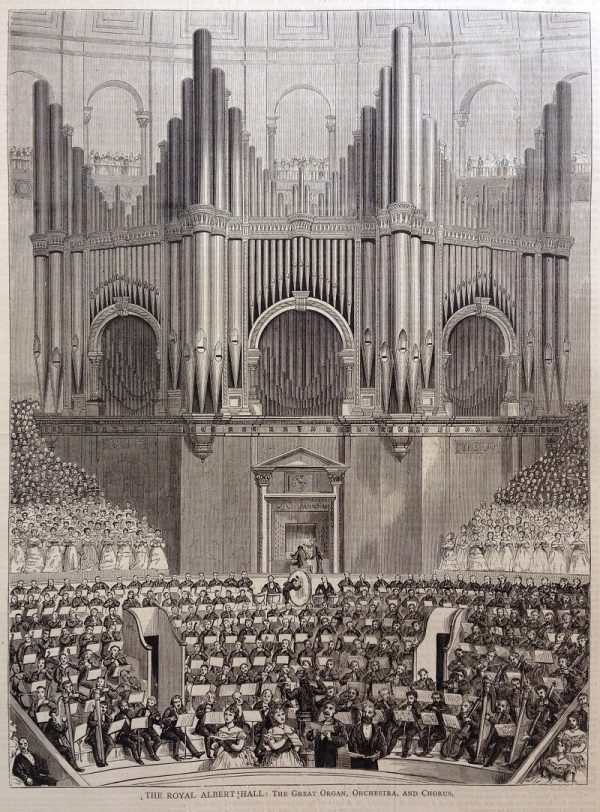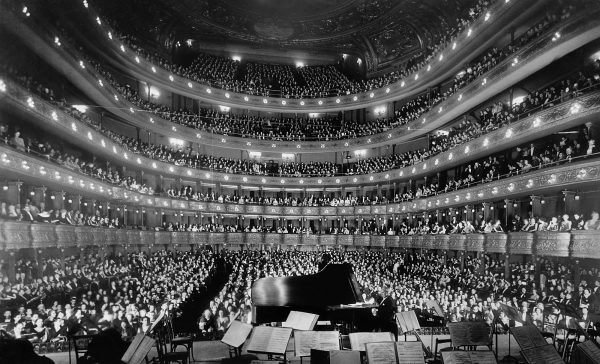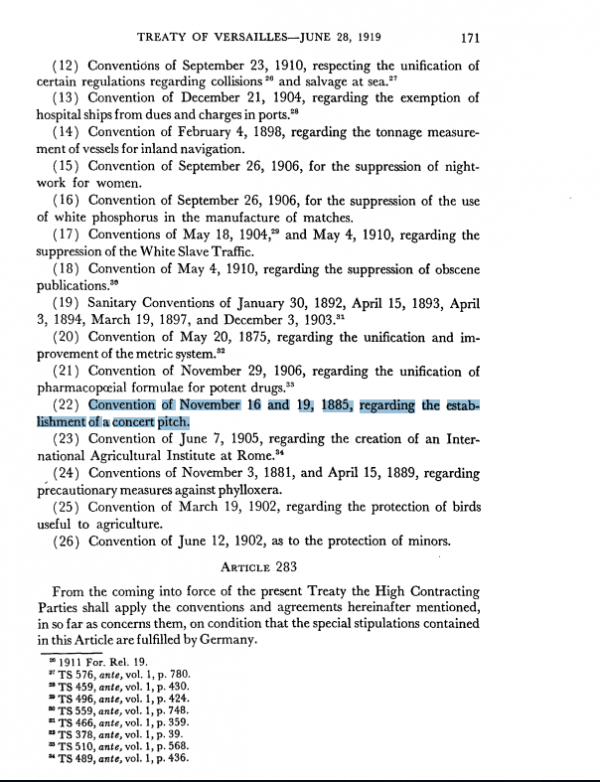Concert Pitch by Sean Real
Western tuning is the most common musical tuning system we have today and was standardized so that musicians can be on the same page as one another. It’s based on the A note above middle C (also known as Concert A) being calibrated to 440 hertz or cycles per second.
During the Medieval, Baroque, and Renaissance eras, local orchestras mostly based their tuning around the church’s pipe organ. Since pipe organs are temperamental and needed the most amount of maintenance it made sense for orchestras to base their tuning around the organ. This put Concert A on a range between 374hz and 567hz. And as orchestral music moved away from the pipe organ, most orchestras were tuning Concert A between 415hz and 430hz.

In the 19th century, however, European concert halls were being built larger and larger, and this was causing orchestras to tune much higher than 430hz. In a large room, lower frequency notes would travel farther than higher ones, and higher frequency notes would also be more easily absorbed by construction materials and people’s clothing. The high notes would be dampened and the whole orchestra would sound dull. To compensate, orchestras would tune higher and higher to achieve a brighter sound.

This put string makers through their paces because older strings made from gut would be snapping constantly, so strings made from steel and nylon were developed to meet this rise in tuning. Opera singers were affected probably the most. Singers were straining their voices trying to sing classic pieces that were originally written between 415hz-430hz. The strain on singers got the attention of the French government and is largely what lead to a number of attempts at creating a standard tuning, including a mandate for Concert A to be 435 Hz in article 282 of the 1919 Treaty of Versailles.

London’s Royal Philharmonic Society would still tune higher to about 439 Hz though. This was because the mandate specified that Concert A should be 435 Hz according to a tuning fork of a specific weight at 15 degrees Celsius. The temperature was specified so that the metal tuning fork could be accurately reproduced, but British orchestras reasoned that their concert halls were warmer than that, and so to compensate they would tune higher.
It wasn’t until 1939 that another conference of nations decided to convene and establish one standard tuning once and for all. The advent of radio broadcasts had made it impossible to ignore because you could hear orchestras tuned at different frequencies back to back. At this conference, it was decided to set Concert A at 440 Hz no matter the temperature of the concert hall.



Comments (7)
Share
RE: Concert Pitch by Sean Real
RE: Concert Pitch now
Orchestra directors are still playing with concert pitch. Not certain, but I heard San Francisco is A=441, many are at 442, and Von Karajan pushed his orchestras as high A=452.
RE: Temperament – A great area to explore
Great book about temperaments, which is even more fascinating than tuning pitches, is Temperament by Stuart Isacoff. There were huge arguments over it and J.S. Bach’s “Well-Tempered Clavier” was a theoretical work (although it is a series of 48 Preludes and Fugues in every key) because equal temperament was a controversial idea in Bach’s day. There are several different temperament systems and several are used now. Choirs and Instruments use either just or a combination of just and Pythagorean tuning. Ragnar Bohlin with the SF Symphony Chorus is all about tunings and his choirs (generally toward the end of the season) show it!
Finally, glad you posted Vivaldi in A=415 Youtube
Historically Informed Performance (HIP) has been around for a long time in the 20th/21st centuries and Early Music musicians are all over the tuning, techniques, and using instruments of the period (or facsimilies) Andrew Parrott’s groups do original tuning. I had the opportunity of hearing Mozart’s “Marriage of Figaro” with period instruments and lowered tuning. I am not a Mozart afficionado, but with period instruments and lowered tuning ,I fell in love with Mozart. It was a completely different experience! The San Francisco Early Music Society can link you up with performers and scholars!
Cheers! Keep exploring: Music has a lot of “invisibleness” by design!
On the Dutch bond value: A Dutch guilder (‘Gulden’ in Dutch) is valued in 100 ‘cent’. And a ‘stuiver’ is simply 5 cent! In the report is was mentioned that a guilder is „20 stuivers“, 20 times 5 cent equals 100 cent, which gives one guilder.
This has been the case until the introduction of the Euro also in Holland.
So 1 stuiver was almost the same as one Belgian Frank. Interesting 🤔 never knew this!
The concert pitch story is totally missing any mention of the Historically Informed Performance (HIP) movement in classical music which aims to play classical music as the original composers had heard it, on historically-accurate instruments and using historical tuning (usually around A=415). Even a layperson can hear the differences in tuning and style:
Beethoven’s 3rd Symphony played by the Orchestra of the 18th Century under Frans Bruggen on period instruments and tuning: https://youtu.be/5DFJ-8tdrTA?t=120
The same piece played by the Vienna Philharmonic under Leonard Bernstein on modern instruments and tuning: https://youtu.be/W-uEjxxYtHo?t=25
There are at least a dozen world-class period orchestras who specialize in historical performance (see https://en.wikipedia.org/wiki/List_of_early_music_ensembles), the best-known of which are the Academy of Ancient Music, Concentus Musicus Wien, the English Concert, the Orchestra of the Age of Enlightenment, and the Orchestra of the 18th Century.
There’s also a number of soloists who similarly play on period equipment (Rachel Podger and Andrew Manze are the most famous violinists). For piano pieces, Robert Levin has recorded most of Mozart’s best known piano concertos on period-accurate fortepiano instruments. This just scratches the surface, and would make a great 99PI story.
So you don’t need computer modification to hear period-accurate tuning, you just need to fire up Youtube or Spotify and listen to some great musicians who are keeping old music alive today.
Not precisely bearer bonds but, to this day, the design of English bank notes includes a printed promise from the Bank, such as “I promise to pay the bearer on demand the sum of ten pounds”. I have always been curious what the Bank of England would give me if I arrive and ask them to make good on this.
On concert pitch, being obsessed with Bach at one point I was well aware of baroque music ensembles that tune their instruments to the appropriate historical tuning. I also was looking this up and found that contemporary musicians like Jimi Hendrix and U2 tune down a semitone for greater resonance. When I tune my violin by ear I always end up about a semitone flat from A440. I wonder if that is a somewhat “unnatural” tuning to my ear?
Something else to explore: Temper. Around Bach’s time there were many ways to tune a piano/ klavier. Not just in terms of the central pitch but how far each tone is space from the others. Perfectly “even” temper (equal spacing of tones) ends up sounding out of tune to our ears. So thus Bach’s “well tempered Clavier”. I’m far from an expert, but I think there is a whole show’s worth of stuff to explore w/r/t tuning and pitch!
Parts of Richard Feynman’s memoir, “Surely You’re Joking, Mr. Feynman” talk about life at Los Alamos during the war.